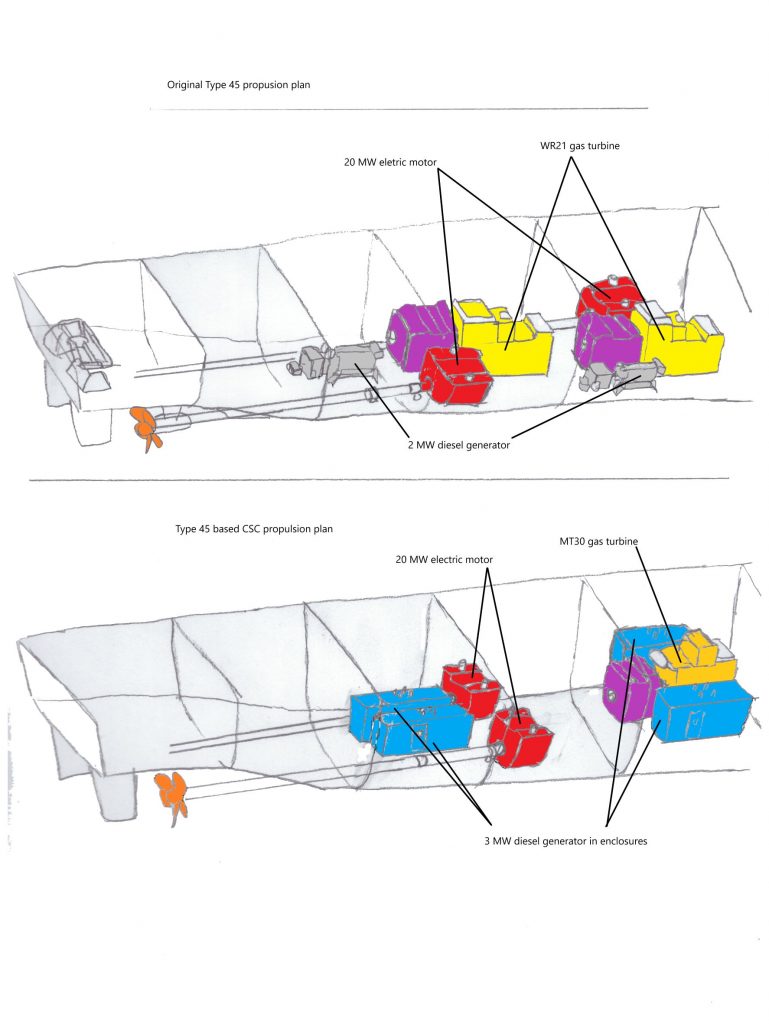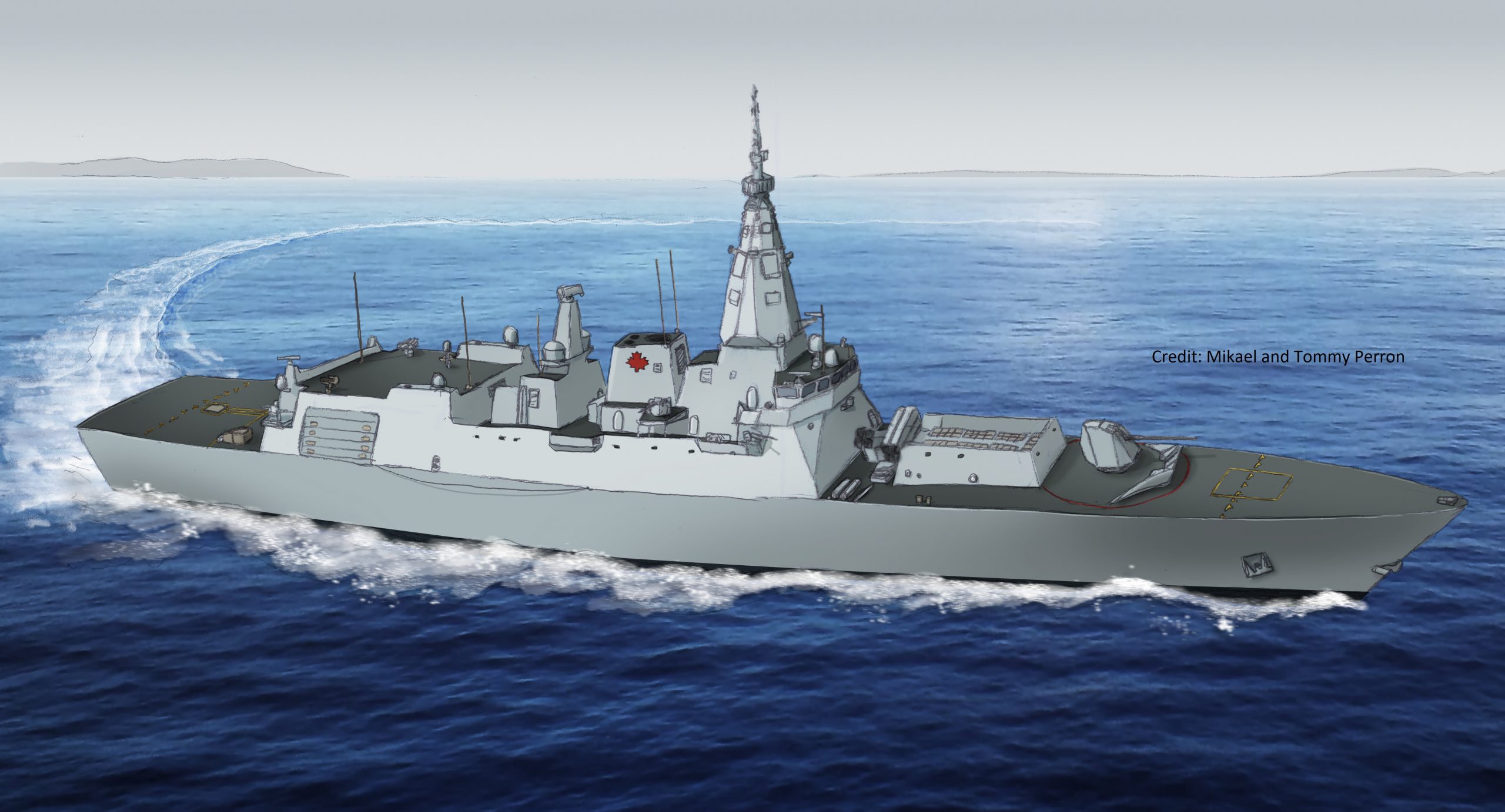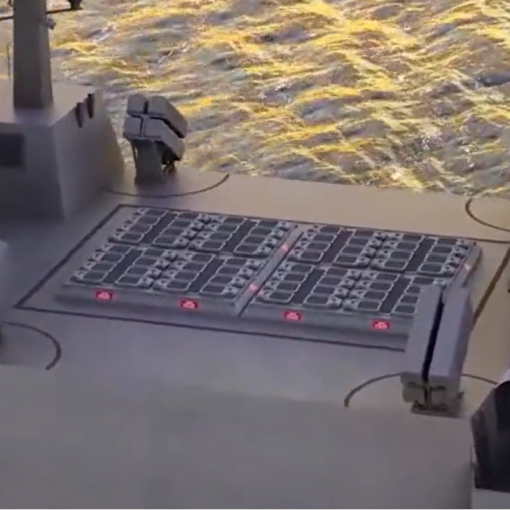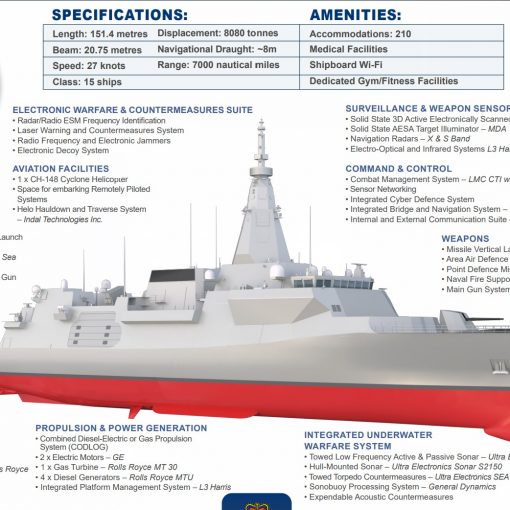By Mikael Perron, 1 April 2022
I was reading a status report of the Daring-class destroyer and looking at the pictures, and I realised how well the Canadian Surface Combatant (CSC) mast would fit where the main mast featuring the SAMPSON radar is located on these ships. I then went through the specifics of the Type 45 in my mind -- I realised that it fits the RCN’s known requirement much better than the Type 26 frigate. When Canada decided to go for an off-the-shelf design for the CSC program, it should have been receiving bids that included already operational platforms. Of course BAE was willing to sell it a brand new ASW design and maximise the supply chain out of it, but it was still a paper ship far from being off-the-shelf. France and Italy wanted to sell Canada the FREMM design, the first ship of which became operational in 2012. Alion was proposing the Dutch LCF design dating back 2002 and Navantia the F105 frigate which became operational in 2002. With the first of class commissioned in 2009, the Daring-class destroyer was also a true off-the-shelf design. The initial requirement of the Request for Proposals (RFP) got modified to include the Type 26-based bid but it should have been the Type 45.
There are two major drawback of the Type 45 design but that could be easily corrected for a Canadian version. First, when Canada decided on going off-the-shelf, the Daring-class was receiving bad publicity because of its recurrent power failures at sea. The source of the problem was the regenerative cycle WR21 gas turbine (GT) that does shuts down sometimes when operating in warm waters. The ship’s ground-breaking Integrated Electric Propulsion (IEP) receive power from two such 21.5 MW GT and two 2MW diesel generators (DG). While fixing a fleet of operational ships is a challenge that will take the form of a replacement of both 2MW DG by three 3MW DG, building new ships offers a great option!
The solution actually comes from the Type 26 frigates. The forward WR21 GT can be replaced by a MT30 GT driving a generator (the same configuration as the Zumwalt-class destroyer and Queen Elizabeth-class carrier). This engine is almost twice as powerful while being much lighter and much more reliable (21.5 MW vs 36 MW). The aft WR21 would also be gone and the same four enclosure-mounted MTU Type 20V 4000 M53B high-speed diesel generators from the Type 26 design would be fitted. These diesels are widely used not only by the forthcoming Type 26 frigate but also the German F125 frigates, US Constellation-class and the Spanish F110 frigates. The ship would then possess 48 MW of electrical power to supply the two 20 MW propulsion electric motors and hotel load. It could also eventually feed some direct energy weapon that could be installed where the two Phalanx CIWS now stands on the UK variant.
It would probably operate only on DG for speeds up to 18-20kts and then turn on the GT for higher speed. It would probably be even more fuel efficient than the original Type 45! The Type 45 have a larger hull than the Type 26 and the nature of the IEP allows for a very flexible installation of the machinery. That configuration would also correct one thing that troubles me about the Type 26. When a Type 26 goes along at maximum speed on the GT mechanically driving the two fixed-pitch propellers and needs to do a crash stop, it needs to cut down throttle while unlocking the sss clutch so it would disengage as the gearbox slows down, then lock itself disengage so reverse torque can be applied by the electric motors. That reverse torque would also vary depending on the number of diesel generators operating at that moment. That makes for a lot of things to happen in an emergency situation!

The second drawback of the Type 45 is that it is not designed as an acoustically quiet ship. For cost-cutting measures, its diesel generator are not even in acoustic enclosures. Once again, the Type 26 technology comes to the rescue first by the engine change mentioned above. Then the large hull allows for an easy acoustic mounting of any piece of gear and much of it can be common to the Type 26 design. Also the pictures of HMS Glasgow seem to show that the engineering section of the hull seems to be covered by acoustic tiles which can be easily replicate for the Type 45 hull. One big question is that the factory producing the electric motor for the Type 26 is the one that produced the motors for the Type 45 and QE carrier. Could it produce both at the same time? I could imagine so for an order of 30 units! Also, is it as acoustically quiet as the new one produced for the Type 26?
Now for the good points, the larger hull of the Daring-class offers more buoyancy and is already designed to receive heavy, powerful and power-consuming radar and combat system. While the CSC mast centred on the SPY-7 radar might be a bit heavier than the SAMPSON radar mast, The SPY-7 radar means the removal of the S1850M (SMART-L) radar, its supporting structure along with the exhaust and intake ducting of the, now gone, aft WR21 GT. This lowers the centre of gravity of the ships and frees up a lot of room in the hangar section which will be discussed further. A compromise was made on the actual CSC design to go without a secondary radar that could easily be fixed with the addition of a Sea Giraffe AMB back aft. There is also plenty of room to fit the Type 45 hull with the same ASW sonars as the actual CSC design. While the ship does not feature a mission bay (containerized mission modules can be left to the Harry DeWolf-class, Kingston-class and its future replacement), both boat bays can easily receive our new multi-role boat. The extra room now available in the hangar could compensate for the absence of the mission bay and allow for the storage of UAVs, for example, while also facilitating the addition of torpedo tubes.
The high freeboard of the Type 45 hull is ideal for navigating the rough North Atlantic with a minimum loss of performance and the type was also able to do 31.5 kts on sea trials. The large hull also means a great growth margin for years to come. The Type 45 design is operated by a crew of 191 but has berthing for 235 people. That is just perfect for our requirement. With the added ASW capability, a Type 45-based ship would probably be operated by a crew of around 200. The extra berthing is perfect to welcome Flag staff, sea training team, Special Forces, trainees or extra personnel in war time. The living quarters in the Type 45 feature modern standards great for the new generation of sailors.
Now for those who worry about the world becoming a tougher place and criticize the punch of the CSC in its actual configuration, the bow section of the Type 45 offers a lot of possibilities. Beginning forward, you replace the 4.5 inch gun by the Leonardo 127/64. After that you have the missile silo section that features 48 cell Sylver launcher that will soon be added 24 Sea Ceptor launcher on the Daring-class. The Sylver launcher has about the same footprint as the MK41 vls so I would see the front section of a Type 45-based CSC fitted with 48 strike length MK41 vls and 12 Exls launcher. A hypothetical load could be for 48 Sea Ceptor missiles, 32 ESSM missile, 24 SM2 block IIIC missiles and 16 Tomahawk missiles. I could see in the future some of the Tomahawk removed for the insertion of the Hypersonic Future Cruise/Anti-Ship Weapon that is to be carried on the UK’s City-class frigates. The area where Harpoon missiles are now fitted would receive the NSM missiles. The ships would also carry the two 30mm guns in the same configuration. I would install the new 0.50 cal naval remote weapon system (NRWS) where the UK fits a mini-gun on its ship and would install a pair on each side of the hangar in the same fashion as the 30mm gun on the Type 26 design in order to cover maximum arc of fire.
I originally thought that it would be easier to add an AAW capability to an ASW-optimized platform but, thanks to the IEP technology and the larger hull size required to carry large radars, meaning a greater growth margin, it looks like the other way around would be much better. I am quite certain that the new Australian and Canadian ships would not suffer as much from weight growth if they were based on the Type 45 design and quite sure that it would not be so difficult to make them exceptionally quiet sub-hunting platform. Both countries will most likely stay the course since that offer was never made to them but I thought that the exercise was worth making






5 thoughts on “BAE and Lockheed Martin may have submitted the wrong bid for the CSC program”
Hello Mikael. In any other scenario, this exercise to use an AAW Type 45 hull would seem to work for the CSC Frigate but the dimensions of the latest CSC Frigate configuration may say otherwise. The Type 45 AAW Destroyer’s Over All Length is 500ft with the CSC Frigate is at 496.7 ft. (not much difference). The Type 45 Destroyer’s Over All Beam is 69.55 ft. vice the CSC Frigate at 68 ft. (only 1.5 ft. difference) The CSC Frigate actually has a deeper Draft at 26.2 ft. vice the Type 45 Destroyer at 24.2 ft. So, all-in-all no real advantage to buy a Type 45 hull design for the CSC Frigate. The SPY 7 AAW Radar is actually higher than the UK AAW Radar which would give it better ranges. The MDA X Band illuminator radar on the CSC Frigate will be a much improved AESA designed radar over the Sea Giraffe AMB as well. The only problems I have with the CSC design is the 24 MK 41 Extended Length vice 32 as it was originally configured however your 48 cell EXls MK 41 launchers would certainly be useful. The CIADS VLS Cells could be extended to 24 vice 12 (2 missiles per cell) since the Sat Com antennas have been moved forward to the base of the SPY 7 radar mast. There is already space designated for our new Gargoyle UAVs. The higher freeboard of the Type 45 would certainly help though. Since the CWIS has been removed from port/stb’d midships on the CSC Frigate, there could be room for future DEW Laser weapons systems on either side. Overall a good “discussion” for the Type 45 “Destroyer” but I still believe the CSC Type 26 “Frigate” is a better choice overall. Cheers!
Hi David. The initial idea of the exercise was about figuring what would have been the BAE’s bid if the rules did not get modified to accept the Type 26 design which was definitely not an off-the-shelf design. As for the dimensions, while the Type 45 seem to be only a few feet bigger than the Type 26 design, it actually has a much bigger internal volume. I would say about a complete deck worth of internal volume from the stern to about the bridge. That is where the higher freeboard comes from. I believe that it is the Sampson radar that does the job of the SPY 7 on a Daring class destroyer. It consists of two AESA radar back to back that are spinning. It kind of combines the Sea Giraffe and illuminator jobs while the SMART-L radar does the long-range stuff. So the SAMPSON is actually higher but, either on the actual CSC design or the hypothetical one, the SPY 7 sits at about the same height and it is a much more advanced design than the SAMPSON. The proposition of an added Sea Giraffe AMD only offers a back-up radar which the CSC now lacks. While the CSC generate 12 MW of electrical power, all of that power might be used when cruising at maximum diesel-electric speed with every radar and system powered up under tropical conditions, let alone the addition of any DEW Laser weapons. On the other hand, a Type 45 would offer 48 MW of Electrical power which mean a big 8 MW still available while steaming along at maximum speed! Going back to the real CSC, I was wondering why not to fit 6 Exls launcher in front of the 24 MK41 cells? After all, The UK’s City class will carry 24 Sea Ceptor behind the main funnel and an extra 24 just in front of the same 24 MK41 cells. What will Canada fit in that empty space? I don’t believe that an extra 24 Sea Ceptor would make it that much heavier. Also it would help to maximized the load of the few precious MK41 cells available (fewer ESSM for more SM2).
Cheers,
Don’t know what Canada will fit in that empty space where the other 8 cell MK 41 VLS was, but in my opinion…why not just fit another “empty” 8 cell VLS there (fitted for but not with). And if they are not going to use the “Lido Decks” for anything then why not just cut it out and save space & weight!! As I said before, you can still install another 12 cell VLS beside the other just aft of the funnel where the Sat Com antennas used to be.
The Type 45 Destroyer carries more fire power that this Type 26 frigate and when you are traveling in the Yellow Sea or North Atlantic East of Greenland this would act in your favour. The new Russian Destroyers / Cruisers are very heavily armoured. Also the Type 45 Destroyer when outfitted right could have a large area in the centre of the ship with detachable walls could be used for first aid areas/Hospital/ humanitarian usages? I would add twin 50 Cal electric Gatling type guns which can operate together or independently 90 Degree from centre or
I would add twin 20 MM electric Gatling type guns which can operate together or independently 90 Degree from centre?
The adding of all the latest surface to air / surface to surface/ surface to sub-surface missiles is only logical, along with today’s version of the Tomahawk ship to ship/ ship to land cruise missiles. In today’s world Canada’s new war ships have got to be (using an old saying) LOADED FOR BEAR and then some. Thanks. Roderick
Agree Roderick that the Type 45 has more fire-power than the CSC Type 26 Frigate and being “LOADED FOR BEAR” as you say would be ideal for the CSC however, it is not what Canada wanted for this ship. It is designed to be an ASW platform with “some” destroyer-like qualities. We are trying to replace what we had in the Iroquois-class and Halifax-class with one ship. Whether this works or not is yet to be seen. Also don’t forget the total “full load-out” weight for the CSC is expected to reach 9,400 tonnes as is, so any more weight will not be a good thing as far as speed and stability go. “Future-proofing” the CSC has been seen by most as a lost cause. Cheers!